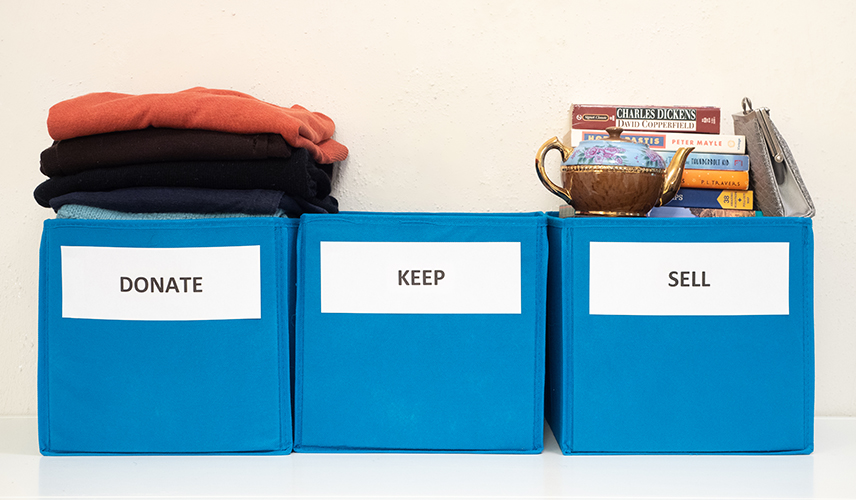Guide to Downsizing
Living in a larger home may have been a dream come true at one point in your life, but it can become a monumental burden for aging adults. Downsizing provides a solution. However, moving into a smaller residence comes with its own set of worries, and paring down a lifetime’s worth of belongings often appears overwhelming.
Several practical strategies will make the process less daunting. When and how you declutter makes all the difference. In the end, you’ll find yourself less stressed and ready to take on the next stage in life… regardless of whether or not this next stage entails a move. Let’s review ways to cope with downsizing and maximize the benefits of simplifying your life.
Benefits of Downsizing
Many older adults decide to downsize and move into a more manageable home or continuing care community . Empty-nesters find they no longer need or desire to maintain a multi-bedroom home. For such individuals, downsizing has many benefits.
- Fewer chores: Larger homes require more work. Downsizing comes with less maintenance and fewer, possibly less costly repairs.
- Lighter burden on others: Whether you move into a more manageable home or a continuing care community, downsizing will help reduce your reliance on loved ones.
- Healthy and active social life: Moving into a community with other retirees will help you stay physically active and socially engaged with new friends.
- Peace of mind: Later retirement comes with a unique set of what-ifs. Downsizing to a ranch house, for example, alleviates some of those worries. A retirement community adds financial peace of mind, with a plan in place in case of cognitive or mobility decline.
- Flexibility and Mobility: A smaller home or a retirement community typically offers a more accessible and age-friendly environment. Downsizing can make it easier to navigate and maintain independence as you age. With less square footage to manage, you may find it easier to adapt your living space to any mobility challenges that may arise in the future.
How to Downsize
Once you’ve decided to downsize, you might not know where to begin. You may have lived in your current home for decades. However, once you get started, you’ll find downsizing to be a rewarding and worthwhile endeavor if you aren’t too rushed. Follow these tips for downsizing to make the task feel more manageable.
Declutter Early
The process of going through all your belongings is physically and emotionally taxing. It’s helpful to start decluttering at least a few months before your move, if possible. Giving yourself ample time will help you avoid stress and the financial burden of renting a storage unit. Breaks and snacks will help you stay on top of the job. Decide in advance at what time you will stop for the day, and stick with it.
Out with the Old!
Moving into a smaller home will feel more inviting after sorting through your belongings. Go through everything in your home, from big furniture pieces to notebooks from way back. Do your best to sort your possessions into five categories.
- Keep: Limit how much you decide to hold onto — allowing yourself to fill only a designated space will help. Focus on keeping practical items you will need, like cooking supplies, clothes and hobby equipment. Keep only the most meaningful mementos.
- Give: If you have sentimental items you want to keep in your family but have no space for, consider giving them to a loved one. The point isn’t to overload your loved ones — instead, only give them what you think they will cherish. You may want to color-code items with stickers: green goes to David, red goes to Cindy…
- Donate: You may run into things in good condition that are no longer useful to you. Whenever possible, consider donating. Remember, you can write donations off on your taxes. Nonprofit agencies in your town will be glad to distribute some of your belongings.
- Sell: If you have valuable items you decide not to keep or give away, you can sell them instead: It may make your move less of a financial burden. Consider joining a neighborhood yard sale. However, be emotionally prepared if the proceeds do not match your expectation, which has no bearing on the worth of your life or your memories.
- Toss: Throw out anything you cannot keep, sell, donate or give to a loved one. Do not “freeze” at the prospect of discarding ancient board games or children’s drawings. Trust us: you will get over it.
This process will take time, and you might have to reevaluate items more than once. However, in the end, you’ll find yourself with your most valued possessions. The following strategies will help you through some decisions. If your individual situation makes it impossible to start decluttering on your own, the Sales Counselors at Cross Keys Village can suggest a professional who will assist you through the process.
Digitize What You Can
While massive filing cabinets and bulging storage bins may have been fixtures in the past, modern technology allows for digitizing documents, photographs, movies, music and everything in between. You can save a great deal of space by scanning the things you want or need to keep and holding them in digital storage. While you might save a handful of physical photos, digital scans will preserve precious memories.
Remember the One-Year Rule
One helpful tip for downsizing is the one-year rule. When deciding whether to keep an item, ask yourself if you have used it at all in the last year. If the answer is no, odds are you do not need to hang onto it. The rule allows you to hold onto things you might not use every day but use during at least one season of the year.
Use Multifunctional Furniture
You might feel tempted to keep extra beds, dressers, closets and other furniture pieces for potential guests. These things can end up taking a lot of space. You can still accommodate guests using multifunctional furniture. Think about investing in a futon, pull-out couch or other multipurpose furniture items, such as a coffee table that doubles as storage space.
Remember Vertical Space
Often, vertical space has the potential to provide the extra storage you need. For example, rather than putting your shoes on the closet floor, you can hang up a shoe rack to save floor space. Make use of shelves, key racks and other wall-mounted storage items. If you’re low on floor space, invest in taller, narrower furniture. For example, using a taller bed frame allows you to store belongings under your bed.
Know How Much Space You’ll Have
It’s wise to have exact measurements of how much space you’ll have in your new home. When downsizing, it can be challenging to know what furniture pieces will fit and which ones will not. It’s better to be safe than sorry — know the dimensions of each room in your new home’s floor plan and how they’ll differ from your current home. An interior design professional can help you plan at moderate cost.
Join Cross Keys Village
Though it is a significant adjustment, downsizing is the right choice for many older adults. Moving from a large home into a continuing care community provides peace of mind during life’s later chapters. It allows older adults to focus on remaining healthy, active and socially engaged, without worry about home upkeep and maintenance.
If you’re researching continuing care communities, consider Cross Keys Village. We offer active, purposeful and affordable retirement living with a strong sense of community. At Cross Keys Village, you’ll enjoy the very best in independent living without the cost premium you would be charged for similar villages near Lancaster or Philadelphia.




